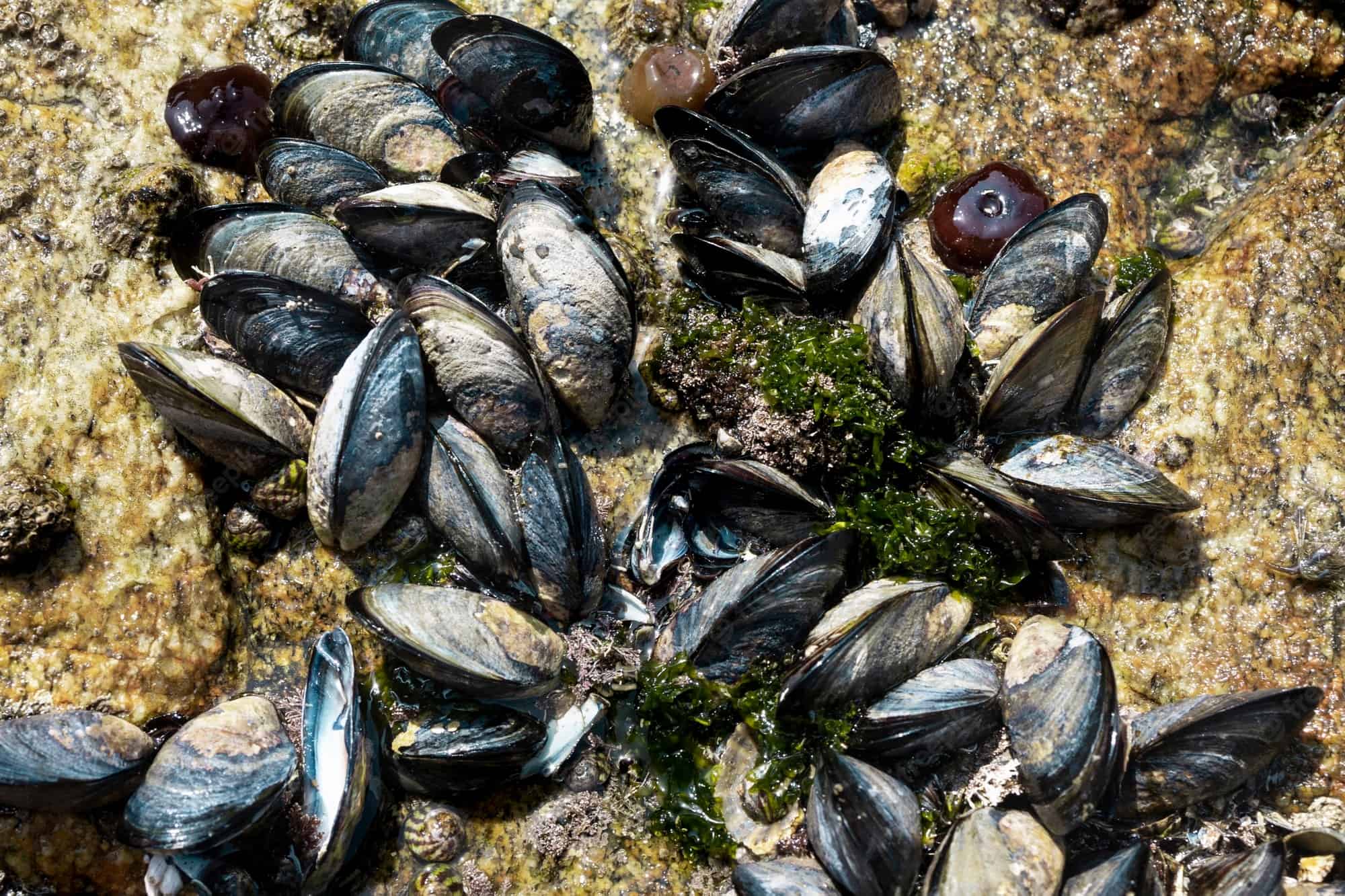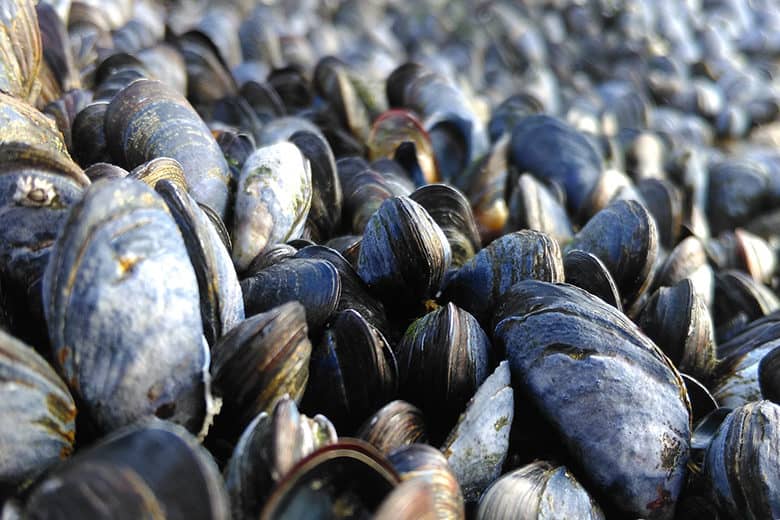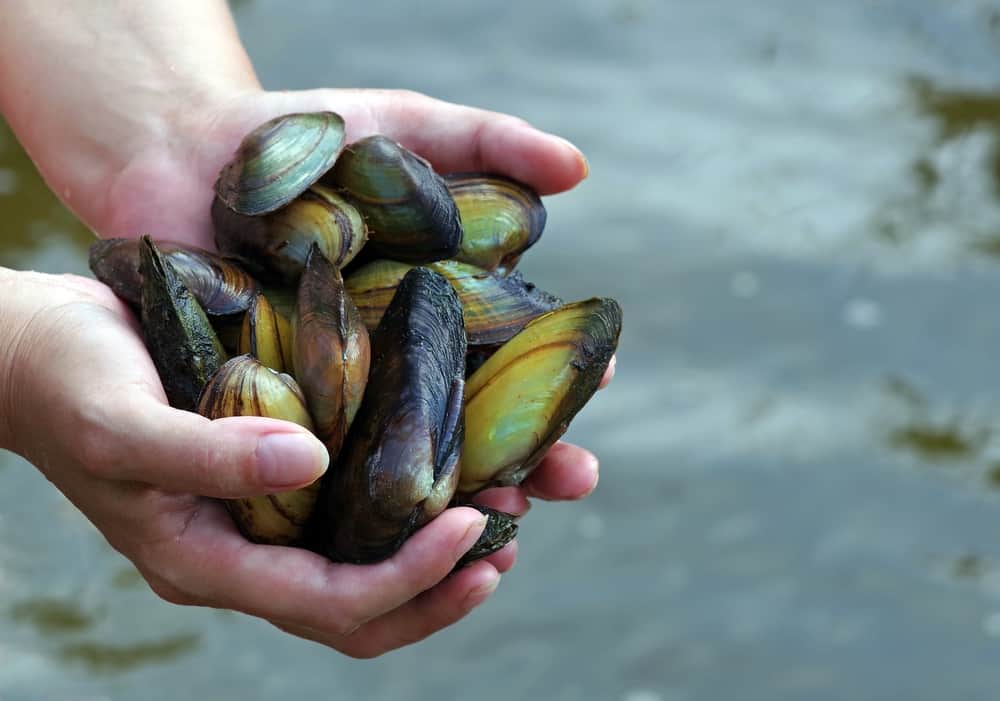Mussels are one of the most extraordinary animals out there. They’re found almost virtually anywhere in the world and can make for both delicious meals, and good pets. But as popular as they are, not many people know much about them.
Today, we’re going to teach you all about these fascinating creatures.
From finding out how to cook and preserve them, to figuring out what mussels eat and where they live – you’ll soon become a mussel expert with our help!
Facts about mussels

What are mussels?
Mussels are perhaps one of the most peculiar-looking of animals around the world. And many people have questions about what they are.
The name mussel refers to a wide species of bivalves or bivalve mollusks that are found all around the world.
With over 1,000 mussel species, they are diverse animals and can be found easily enough in lakes, streams, rivers, and ponds.
They are quite simple, basic creatures, with two shells and one valve that protects the soft, inner creature inside. A large, muscular foot inside is used to propel the mussel through the water.
Like fish, mussels also have a series of gills that help them breathe underwater. The gills also help filter food and store and incubate offspring.
Mussels are often harvested to be used in cooking, but can also make for good pets in the right conditions. They can live up to 60 or 70 years in good habitats.
Do mussels have feelings?
Perhaps because of their strange appearance, people are often curious about what a mussel can and can’t do. Do they have feelings? Emotions? Like other animals?
The short answer is no, mussels do not. That is because mussels have an underdeveloped nervous system, and don’t have a brain.
Scientists classify them as not being sentient, and they do not form any thoughts or experience pain as we do. For this reason, many vegans are perfectly LOK with eating mussels.
How long can mussels be kept alive?
So you’ve bought these fascinating creatures and are wondering how long they will keep alive and fresh?
Mussels can spoil quickly if not kept in appropriate conditions. There is a real danger to eating spiled mussels because they can be a haven for harmful bacteria.
Generally speaking, mussels can keep in the fridge for 3 to 5 days. Proper storage is therefore your main priority!
Once cooked, mussels should be kept in an airtight container and refrigerated within two hours of cooking. Properly stored mussels will last between 3 and 4 days.
Although you can freezer mussels, which can extend their use for up to 3 months and more, it’s not recommended. Freezing can alter both flavor and texture and denies you their true potential.
How do you know when mussels are bad?
Looking at a mussel and wondering if it’s safe to eat or not? There are three ways of telling if a mussel has spoiled or not.
The first and easiest way of knowing is by smelling the muscle. If it smells unusual or sour, you should discard it immediately.
Next, check the texture. If the mussel shells are slimy, chances are bacteria have already started to cultivate.
Lastly, test the mussel’s shells. Press them together – if the shells do not close by themselves, this means the mussel is dead.

How do I identify mussels?
Mussels are an incredibly diverse group of animals. There are several ways to identify them – but the easiest and most commonly used method is examining their shells.
Mussels have different shell shapes, textures, valves, and ridges that can identify them immediately. Discover Life has an easy-to-use mussel identification database, where you can find specific breeds based on shell shape, pattern, color, and surface.
There are over 17 edible types of mussel, the most common of which is the blue mussel. They are triangular-shaped, smooth, long, and elongated, with radial stripes.
Another common species is the zebra mussel, which is considered an invasive species in several countries around the world. It is the size of a fingernail and so is not generally worth collecting for their
Differences between males and females
You can tell the gender of a mussel by opening git up and examining the color of the meat. Male mussels are pale, whereas females are orange.
What do mussels eat?
You can learn a lot about an animal by knowing what it eats.
Mussels are what we call filter feeders. They feed on microscopic organisms like plankton, algae, and detritus.
Because they mostly stay in one place, the location of mussels can impact their quality.
If the mussel is in a polluted body of water, this can negatively affect its taste, texture, and overall health. Similarly, as is the case with many farm-raised mussels that grow in clean water, they usually are healthier and more nutritious.
Uses of mussels
1. Pet
Because of their natural ability to siphon water, some aquarium owners often ask can they be kept as pets? After all, they can help clean a tank by simply living there.
The answer is – yes! Mussels can make great pets in a fish tank. Because they only feed on microscopic particles, they are no threat to your aquarium fish.
Mussels strain out particles in the water and can help reduce pollution and harsh chemicals, especially important in keeping freshwater pets. They are a natural way to increase water quality.
That said, it’s important to keep them in good health, as a dead mussel will attract harmful bacteria quickly.
Keep your tank at an appropriate temperature (73-76 °F) and avoid sediments that can degrade their shells. You should also avoid any species of fish that may prey on them.
How do you keep mussels alive at home?
Like any shellfish, mussels must be preserved in specific conditions to remain fresh and safe to eat.
Here are some tips to keep in mind:
- Keep them cold, between 8 °F and 39 °F
- Store them loosely in a bowl so they can breathe.
- It’s important to keep them wet – but never fully submerge them.
- Don’t seal them in a container, either.
- Discard your mussels if they smell odd, feel slimy or crack/break in any way
2. Food – How to cook mussels?
Mussels are versatile meat. There are a variety of different ways to cook and flavor them.
The most popular technique is by steaming. Steamed mussels retain their signature taste, texture, and nutritional value and are quicker to cook this way than by boiling them.
Steaming recipes you can try out include:
- Steamed mussels with cider, spring onions & cream
- French Steamed Mussels in a white wine and garlic cream broth
- Steamed mussels with curry, leeks, and saffron cream
3. Bait
As well as eating them, humans have another important use for mussels – as bait to lure larger prey!
Several types of fish love the taste of mussels, including:
- bream
- whiting
- flathead
- cod
- trevally
- perch
- mullet
- trumpeter
- mackerel
- trout
While stale mussels can be used as bait, we recommend using fresh mussels, which have a stronger scent that is more effective at attracting fish.
Making your bait is straightforward. Pry open the shells and use a blunt knife to scoop the mussel out.
The mussel will be gooey and loose, so tie a string around it to keep its shape intact. Tie the other end to your fishing hook and voila – your ‘live’ bait is complete!
What predators eat mussels?
As we’ve learned thus far, mussels are tasty treats and more or less defenseless. It’s no surprise they have numerous predators.
The most common predator are seabirds, including gulls, geese, and ducks. These birds dive underwater to collect buried mussels or prize them off rocks. Using their beaks, they can easily break through the mussel’s tough exterior.
Otters, raccoons, and muskrats are also common predators of mussels, seeing them as an easy meal.
The life cycle of a mussel
Mussels continue to be fascinating creatures. They can live for up to 70 years in a good environment, though their life cycle is quite simple.
Let’s take a brief look at them:
- Fertilization: The male mussel releases sperm, which is drawn into the shell cavity of the female, and fertilizes her eggs. These eggs are brooded in her gills.
- Larva: Eggs develop into a larva called glochidia. When they are released by the female mussels, these larvae attach themselves to the gills of a passing host fish, acting as parasites.
- Growth: These ‘parasites’ continue to grow for the next couple of weeks, slowly morphing into juvenile mussels. In time, they detach from their host and fall into the mud or sand below.
